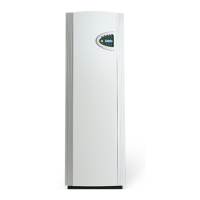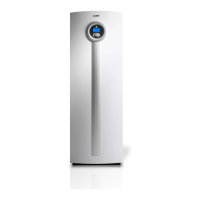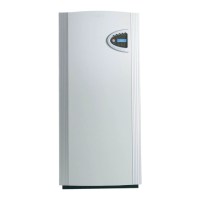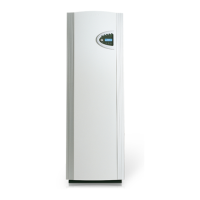Do you have a question about the IVT Greenline HC 22 and is the answer not in the manual?
Explains hazard symbols and provides essential safety guidelines for installation and use.
Instructions for securely attaching lifting belts to the heat pump for safe lifting.
Procedures for safe handling of circuit boards to prevent electrostatic discharge damage.
Covers installation, filling, and venting procedures for collector and heating systems.
Guidance on correct placement and installation of temperature sensors.
Detailed steps for filling and venting various system circuits.
Steps for connecting the heat pump electrically and understanding the phase guard.
Diagram showing the connection between the distribution box and the heat pump.
Lists and defines component codes used in wiring diagrams for various system parts.
A comprehensive schematic illustrating the internal wiring of the heat pump.
Detailed wiring diagram for compressor E21, focusing on high current connections.
Detailed wiring diagram for compressor E22, focusing on high current connections.
Detailed wiring diagram for compressor E21, focusing on low current connections.
Detailed wiring diagram for compressor E22, focusing on low current connections.
Illustrates the external connections to the E21 control unit.
Illustrates the external connections to the E22 control unit.
Identifies all buttons, the display, and status lamp indicators on the control panel.
Guides users through initial setup for language, country, and operating mode.
Details essential parameters to adjust during the initial start-up process for optimal operation.
Procedure for accessing installer-specific menus using an access code.
Defines safety limits and alarm parameters for the collector circuit's temperature.
Guides on modifying heat curves for radiator and underfloor heating systems.
Instructions for adjusting the left and right points of the heat curve.
Determines the day of the week and interval for hot water peak operation.
Details the screed drying process phases and how to activate the function.
Sets start delay, energy supply cut-off behavior, and additional heat only mode.
Defines minimum permitted temperatures and hysteresis for collector circuit sensors.
Provides access to the alarm log and saves historical alarm information.
Classifies alarms by type and seriousness, detailing their impact on operation.
Details alarms related to high hot gas temperature, low/high pressure, and collector circuit issues.
Covers alarms from motor cut-outs, phase errors, and sensor failures.
Describes alarms for high flow temperature, heater overheat, and collector circuit issues.
Details alarms for flow and outdoor sensors indicating failure or short circuits.
Covers alarms related to room and heat transfer fluid sensors (failure/short circuit).
Describes alarms for collector circuit sensors and high flow temperature (T8).
Details alarms for additional heat, screed drying, and CANbus/I/O board communication.
Covers alarms for temporary stops due to limits and program version mismatches.
Explains the content and display of the alarm log, including categories and text.
Guides for checking the refrigerant circuit and setting system operating pressure.
Procedure for checking and topping up the collector circuit filling pressure.
Recommends function checks, cable inspection, and filter cleaning.
Fields for capturing installation data, serial numbers, and component types.
Verifies electrical connections, supply voltage, and performs initial start-up procedures.
Checks sensor connections, circulation pumps, external signals, and basic function tests.
Verifies additional heat operation, external signals, and recorded operating temperatures.











